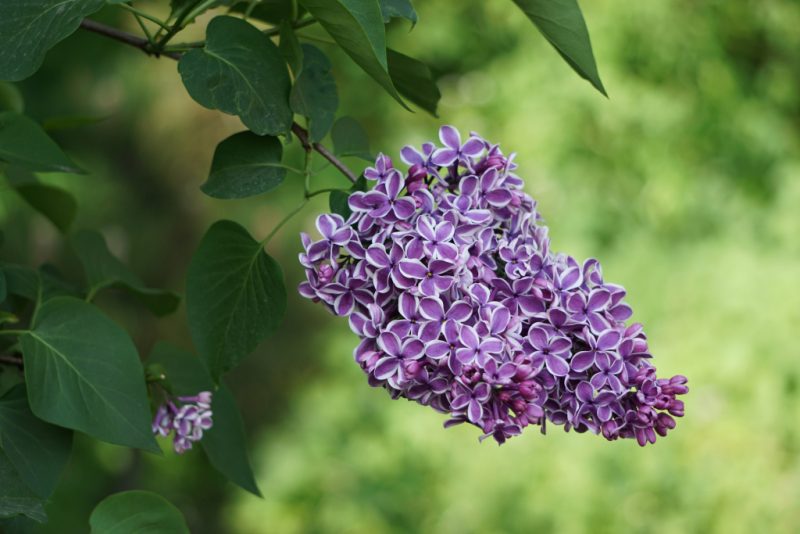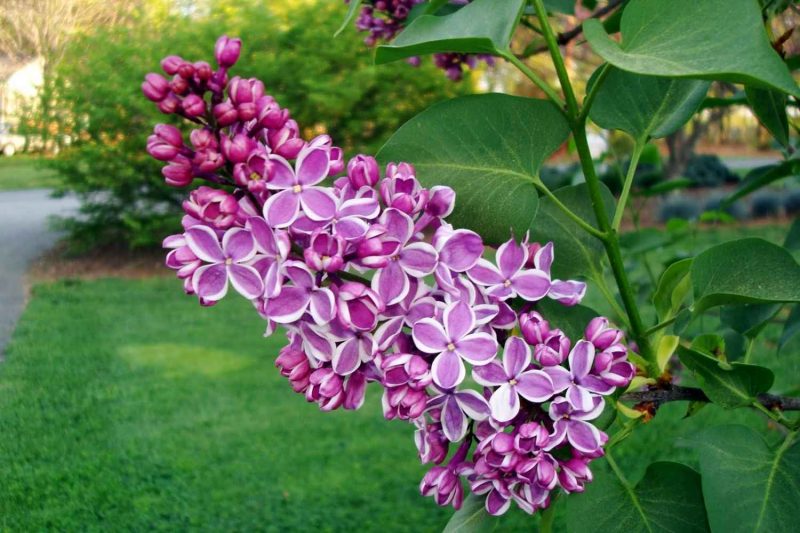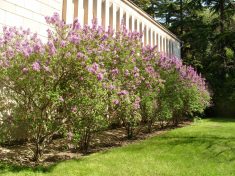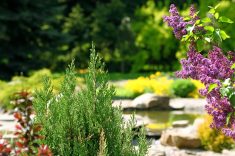Everyone wants to decorate their site with flowering shrubs, among which one should pay attention to the numerous genus of lilacs. But the variety of species and varieties sometimes leads the future owner of the fragrant bush to a difficult choice. Lilac "Sensation" stands out among the species and varietal diversity with an uncharacteristic two-tone color of flowers and an unsurpassed aroma that will surely attract the gardener's attention.
Material Content:
Grade description

The ordinary lilac “Sensation” is represented by late-flowering shrubs with a height of up to 3 m and a similar diameter. The dense crown consists of straight shoots, abundantly covered with wide green foliage. A distinctive characteristic of the variety are purple brushes, consisting of flowers decorated at the edges of a white border, collected in panicles. Flowering is observed in late spring - early summer.
How to plant a plant on the site
The planting of lilacs, before which a sunny and sheltered area is prepared, is carried out in the second half of summer.

Preference should be given to territories with fertile soil of a neutral or slightly acidic reaction.
The technology of planting seedlings is represented by the following scheme:
- On the selected site, digging holes in the form of a cube with dimensions of 60x60 cm.
- A drainage material is placed in the recess in order to avoid further stagnation of moisture in the roots.
- Fertile soil is prepared from compost with a small addition of superphosphate, a small part of which is poured into the drainage.
- Next is a seedling with straightened roots, which, if necessary, are slightly shortened.
- The pit is filled with soil mixture.
- The soil around the trunk is crushed and watered
Outdoor Care
Even an inexperienced gardener will cope with the care of lilac Sensation.

Necessary activities:
- Watering. In the first half of summer, the near-trunk circle of lilacs is moistened after the soil surface dries out at the rate of 2 buckets of water under the bush. Further irrigation is carried out only in the absence of rainfall.
- Soil treatment. After watering or heavy rainfall, the earth under the bush loosens. Weeds are systematically removed.
- Fertilizing and fertilizers. In the first few years of the Sensation lilac, weekly fertilizing with nitrogen fertilizers is required. After reaching the age of three, every 2 years it is recommended to enrich the soil with phosphorus and potassium.
- Crown formation. It is necessary to begin the formation of a bush from the fourth year of life. During spring pruning, the most favorably growing branches are left as skeletal. In the future, the selected form is maintained annually and diseased, injured or growing inward shoots are removed.
- Shelter for the winter. The variety is winter-hardy. But while the bushes are young, it is worth protecting the lilac with an under-barrel layer of mulch and fir spruce branches.
- Transfer. Experienced gardeners know that 2 years after planting in open ground, lilac bushes should be transplanted to a new place with fertile soil, which the plant quickly depletes in the first few years of development and build-up of root, as well as green mass.
- Protection against diseases and pests. Lilac "Sensation" is practically invulnerable and extremely rarely affected by harmful organisms. However, in adverse weather conditions, powdery mildew may be recorded, which should be controlled with fungicide. Among pests, mouse-like rodents pose a serious danger. As protection, special baits are used, which include rodenticide. Also on the shoots can be observed damage to the lilac hawthorn, mining moths, ticks. Insecticides are used to control insects according to the manufacturer's instructions on the packaging.
Pruning Lilac Sensation after Flowering

To maintain the decorativeness of the bush and provide abundant flowering for the next year, pruning of faded inflorescences should be carried out. The procedure must use a sterile instrument.
Plant propagation methods
If you do not take into account the method of propagation by vaccination, which is extremely difficult for a non-professional to perform, then there are two more vegetative methods - cuttings and breeding by layering.

Cuttings due to poor rooting of planting material are carried out taking into account a number of mandatory rules:
- Cuttings are harvested immediately after flowering.
- In this capacity, young shoots are selected inside the crown with 2 internodes.
- Lower leaves are removed from the cut shoots, after which the cuttings are aged in the growth stimulator for at least 16 hours.
For propagation by layering in the spring, a shallow groove is prepared, where only the shoot that is starting to lignify is pinned. When the sprouts emerging from the kidneys reach 15 cm, they are earthed. A similar procedure for the season is repeated 2 times. With the onset of cold weather, the cuttings are separated from the mother bush and divided into parts with roots and shoots. Delenki land in a permanent place.
Use in landscape design
The Sensation lilac variety, which is distinguished by its original color, the shade of which may slightly vary depending on the features of the relief and the site lighting, is often used in landscape design:
- The bush looks spectacular in group plantings with other flowering and ornamental shrubs.
- When decorating a flower bed or flower bed, the Sensation lilac with a two-tone color of flowers will also look very organic.
- Sometimes a shrub is used in the formation of hedges in combination with white lilacs.
- For aesthetic pleasure and delight of smell, the plant is planted next to the arbors and windows as a single planting.
Thus, in order to decorate the site with a flowering shrub and not spend much time caring for it, you can opt for the ordinary lilac “Sensation”.















